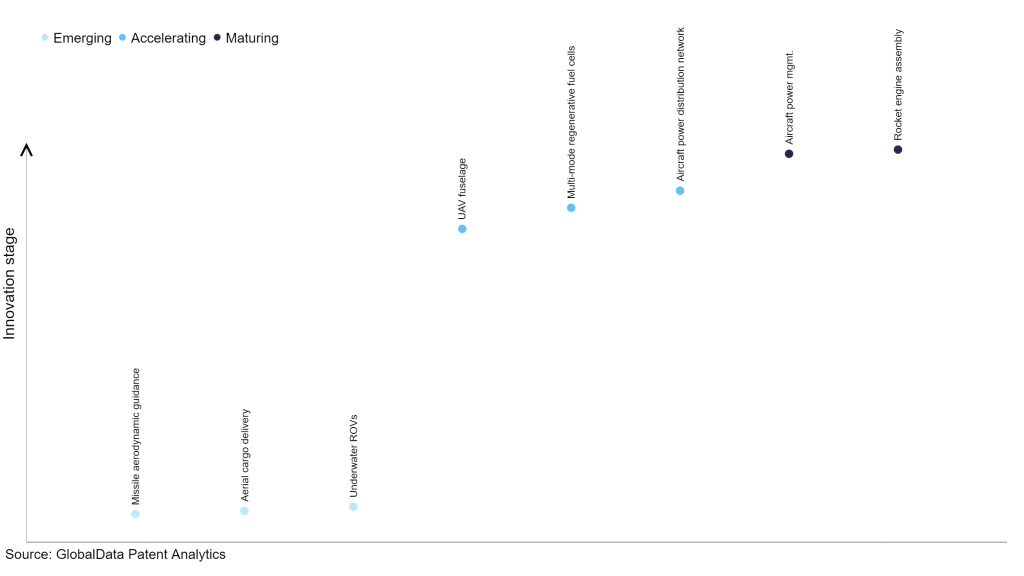The aerospace and defense industry continues to be a hotbed of patent innovation. Activity is driven by automation, environmental sustainability, and operational efficiency, and growing importance of technologies such as artificial intelligence (AI), Internet of Things (IoT), drones, and satellites. In the last three years alone, there have been over 84,000 patents filed and granted in the aerospace and defense industry, according to GlobalData’s report on Innovation in defense: precision-guided firearms. Buy the report here.
However, not all innovations are equal and nor do they follow a constant upward trend. Instead, their evolution takes the form of an S-shaped curve that reflects their typical lifecycle from early emergence to accelerating adoption, before finally stabilizing and reaching maturity.
Identifying where a particular innovation is on this journey, especially those that are in the emerging and accelerating stages, is essential for understanding their current level of adoption and the likely future trajectory and impact they will have.
110 innovations will shape the aerospace and defense industry
According to GlobalData’s Technology Foresights, which plots the S-curve for the aerospace and defense industry using innovation intensity models built on over 260,000 patents, there are 110 innovation areas that will shape the future of the industry.
Within the emerging innovation stage, missile aerodynamic guidance, aerial cargo delivery, and underwater ROVs are disruptive technologies that are in the early stages of application and should be tracked closely. UAV fuselage, multi-mode regenerative fuel cells and aircraft power distribution network are some of the accelerating innovation areas, where adoption has been steadily increasing. Among maturing innovation areas are aircraft power management and rocket engine assembly, which are now well established in the industry.
Innovation S-curve for the aerospace and defense industry

Precision-guided firearms is a key innovation area in aerospace and defense
Precision-guided firearms refer to firearms equipped with technologies that assist in ensuring accurate firing and hitting of targets. This technology typically includes a fire-control system that uses a range of sensors, processors, and control mechanisms to ensure that a projectile hits its target with precision. Precision-guided firearms offer significant advantages over traditional firearms, particularly in situations where accuracy and precision are critical, such as in military and law enforcement operations.
GlobalData’s analysis also uncovers the companies at the forefront of each innovation area and assesses the potential reach and impact of their patenting activity across different applications and geographies. According to GlobalData, there are 50 companies, spanning technology vendors, established aerospace and defense companies, and up-and-coming start-ups engaged in the development and application of precision-guided firearms.
Key players in precision-guided firearms – a disruptive innovation in the aerospace and defense industry
‘Application diversity’ measures the number of applications identified for each patent. It broadly splits companies into either ‘niche’ or ‘diversified’ innovators.
‘Geographic reach’ refers to the number of countries each patent is registered in. It reflects the breadth of geographic application intended, ranging from ‘global’ to ‘local’.
Patent volumes related to precision-guided firearms
Source: GlobalData Patent Analytics
Leupold & Stevens is one of the leading patent filers in precision-guided firearms. It filed patents related to real-time ballistic solutions for calculating an aiming adjustment and for indicating a subsonic threshold, rangefinders and aiming methods using projectile grouping, low-profile auto-locking pinch/turn adjustment knob, ballistic ranging methods and portable systems for inclined shooting, and locking turret knob.
The company supplies its optical products to various entities, including the US military, law enforcement, and government agencies nationwide. Its optics are also used by the armed forces of several allied nations. The US Army has chosen one of the company’s riflescopes as a designated day optic for the Precision Sniper Rifle (PSR) program.
Some other key patent filers in this space include SHELTERED WINGS, Ray Dennis Group of Companies and Cubic.
In terms of application diversity, Cubic, Torrey Pines Logic, and SHELTERED WINGS are some of the leading innovators. By means of geographic reach, some of the leading patent filers include Vista Outdoor, Torrey Pines Logic, and Trijicon.
To further understand the key themes and technologies disrupting the aerospace and defense industry, access GlobalData’s latest thematic research report on Aerospace & Defense.
Data Insights
From

The gold standard of business intelligence.
Blending expert knowledge with cutting-edge technology, GlobalData’s unrivalled proprietary data will enable you to decode what’s happening in your market. You can make better informed decisions and gain a future-proof advantage over your competitors.



